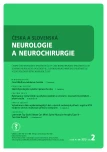Endoscopic Third Ventriculostomy in Previously Shunted Children
Authors:
R. Lipina 1,2; T. Hrbáč 1; M. Chlachula 1; T. Krejčí 1; M. Kunčíková 3
Authors‘ workplace:
Neurochirurgická klinika FN Ostrava
1; LF UK v Hradci Králové
2; Klinika dětské neurologie FN Ostrava
3
Published in:
Cesk Slov Neurol N 2013; 76/109(2): 207-210
Category:
Short Communication
Overview
Aim:
Endoscopic third ventriculostomy (ETV) is a routine and safe procedure for treatment of obstructive hydrocephalus. The aim of our study was to evaluate EVS success rate in treating obstructive hydrocephalus in paediatric patients with former ventriculo-peritoneal (V-P) shunt implantation.
Material and methods:
We performed ETV in 36 patients with former V-P drainage implantation between 2001 and October 2011. Pre-surgical brain MRI performed in all patients confirmed an obstruction in aqueduct or outflow parts of the fourth ventricle. During the surgery, the V-P shunt was clipped and ETV was performed. In patients with favourable clinical condition and functional stoma on MR, the V-P shunt was removed 3 months after the ETV. In indicated patients, the Ommaya reservoir was inserted to enable emergency cerebrospinal fluid tapping.
Results:
Our group of 36 patients involved 11 patients with congenital aqueduct stenosis, 14 patients with posthemorrhagic hydrocephalus, 6 patients with post-infection hydrocephalus and 5 patients with Chiari malformation – associated hydrocephalus. Nine patients underwent unsuccessful ETV in infancy. Patients in whom V-P shunt could be removed three month after the ETV were evaluated as successful; 26 patients (72%) in our group were successful. There was one serious complication in the group – one patient died 2.5 years after the surgery due to delayed ETV failure.
Conclusion:
The ETV is a method of choice in obstructive hydrocephalus even in patients with former V-P shunt implantation. MR is feasible in acute or scheduled V-P shunt surgical revision. Hydrocephalus may be solved endoscopically in patients with confirmed obstruction in the ventricular system.
Key words:
endoscopy – ventriculocisternostomy – hydrocephalus – ventriculo-peritoneal shunt
Sources
1. Brockmeyer D, Abtin K, Carey L, Walker LM. Endoscopic third ventriculostomy: an outcome analysis. Pediatr Neurosurg 1998; 28(5): 236–240.
2. Gangemi M, Donati P, Maiuri F, Longatti P, Godano U, Mascari C. Endoscopic third ventriculostomy for hydrocephalus. Minim Invasive Neurosurg 1999; 42(3): 128–132.
3. Hopf NJ, Grunert P, Fries G, Resch KD, Perneczky A. Endoscopic third ventriculostomy: outcome analysis of 100 consecutive procedures. Neurosurgery 1999; 44(4): 795–806.
4. Bilginer B, Oguz KK, Akalan N. Endoscopic third ventriculostomy for malfunction in previously shunted infants. Child Nerv Syst 2009; 25(6): 683–688.
5. Siomin V, Weiner H, Wisoff J, Cinalli G, Pierre-Kahn A, Saint-Rose C et al. Repeat endoscopic third ventriculostomy: is it worth trying? Childs Nerv Syst 2001; 17(9): 551–555.
6. Hader WJ, Walker RL, Myles ST, Hamilton M. Complications of endoscopic third ventriculostomy in previously shunted patients. Neurosurgery 2008; 63 (1 Suppl 1): ONS168–ONS174.
7. Woodworth G, McGirt MJ, Thomas G, Williams MA, Rigamonti D. Prior CSF shunting increases the risk of endoscopic third ventriculostomy failure in the treatment of obstructive hydrocephalus in adults. Neurol Res 2007; 29(1): 27–31.
8. Lipina R, Palecek T, Reguli S, Kovarova M. Death in consequence of late failure of endoscopic third ventriculostomy. Childs Nerv Syst 2007; 23(7): 815–819.
9. Aquilina K, Edwards RJ, Pople IK. Routine placement of a ventricular reservoir at endoscopic third ventriculostomy. Neurosurgery 2003; 53(1): 91–97.
10. Lee SH, Kong DS, Seol HJ, Shin HJ. Endoscopic third ventriculostomy in patients with shunt malfunction. J Korean Neurosurg Soc 2011; 49(4): 217–221.
11. Cinalli G, Sainte-Rose C, Chumas P, Zerah M, Brunelle F, Lot G et al. Failure of third ventriculostomy in the treatment of aqueductal stenosis in children. J Neurosurg 1999; 90(3): 448–454.
12. Fukuhara T, Vorster SJ, Luciano MG. Risk factors for failure of endoscopic third ventriculostomy for obstructive hydrocephalus. Neurosurgery 2000; 46(5): 1100–1111.
Labels
Paediatric neurology Neurosurgery NeurologyArticle was published in
Czech and Slovak Neurology and Neurosurgery

2013 Issue 2
- Metamizole vs. Tramadol in Postoperative Analgesia
- Memantine in Dementia Therapy – Current Findings and Possible Future Applications
- Metamizole at a Glance and in Practice – Effective Non-Opioid Analgesic for All Ages
- Advances in the Treatment of Myasthenia Gravis on the Horizon
Most read in this issue
- Creutzfeldt-Jacob disease
- Spinocerebellar Ataxia 7 – a Case Report
- Lyme Borreliosis as a Cause of Bilateral Neuroretinitis with Pronounced Unilateral Stellate Maculopathy in a 8-Year Old Girl
- Electrophysiological Examination of the Pelvic Floor
